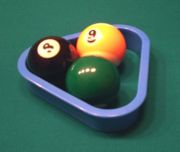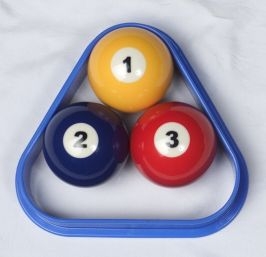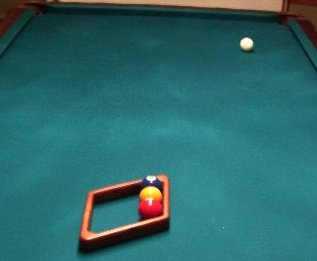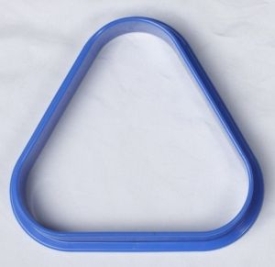3 Ball Rules
The General Rules of Pocket Billiards shall apply for all situations which are not clearly contradicted by these additional rules. 3 Ball Billiard rules are fairly simple, so be sure that you are familiar with the general rules as noted above.
3 Ball Rules
3 Ball is played on a typical six-pocket billiard table, and is based on a system similar to golf, where the number of strokes are counted.
A round of three ball is typically made up of either three or five games, or innings, per player. Each player's individual scores are summed at the end to derive at their total scores for the round. Each 3 ball match can be composed of numerous multi-inning rounds, either spread out over time or back to back. If spread out, rounds can span periods of many weeks. When three ball is played in a gambling context, the 3 ball players typically leave the game at their own free will as their finances or will to risk more money change.
The object of 3 ball billiards is to break, and pocket all of the balls in the smallest number of shots. Balls do not need to contact the rail on the break as in standard billiard rules. Also, most items that would be considered fouls in the general rules would be allowed in 3 Ball billiards, with the exception of the obvious. The obvious would include acts such as contacting and moving the balls with a body part. The shooting player remains at the table until all of the object balls are pocketed, or they reach a pre-determined cut-off score. Points are added to the player's score for specific fouls and for each stroke. Each stroke counts as one point, and fouls are assessed specific point values.
3 Ball is played among two or more players, each of which will play one full game. The player to finish their game with the lowest number of strokes wins. Should a tie unfold, the players in the tie shall play additional games to decide the winner. Any number of players can play three ball billiards. When the number of players is greater than two, players typically play in rotation, however, when the number of players increases past four, the game can become very long.
In three ball rules, there is a pre-determined cut-off score. When a player reaches the 3 ball cut-off score, he or she must concede the table to the other player, who will begin their inning. If the player reaching the cut-off is the last player in the sequence, the game comes to an end. Less experienced three ball players typically set the cut-off score at eight points, while more experienced players typically set the cut-off score between three and five points. Some players will concede the game even before reaching the cut-off score if a loss is imminent and/or a tie impossible. This type of concession is considered to be sportsmanlike conduct and is expected. The player conceding is scored at the cut-off score, not at the score he or she conceded.
3 Ball Rack Rules
A 3 ball rack can be set up in either a standard sized triangular rack, a specialized 3-ball rack (small triangle), or in a 9-ball "diamond rack" (for a straight-line 3-ball rack). There are also specially made three ball triangle racks. See the images below for racking rule details. To compile a three ball rack, no special ordering or placement of the balls are necessary.
Here are some images of how to rack the balls in a game of 3-ball billiards:
How to rack in 3-ball pool:

Proper 3-ball racking diagram:

Using a 9-ball pool rack to rack 3 balls in a straight line for a game of 3-ball:

Specialized racking triangle for three-ball:

Most three ball rules prohibit players from racking the balls when it is his or her turn to break due to the known advantages of certain placement nuances such as tightness and small shifts of the rack's angle. The breaking player reserves the right to request a new rack be built if he or she feels that the initial rack is not formed properly. A standard racking triangle is used to rack the three object balls used to play 3 Ball Billiards. One ball is placed at the head of the triangle, and the other two balls are placed directly behind it.Each game of 3 Ball begins as soon as the cue ball crosses the head string during a break shot. When a foul occurs, one additional shot is assessed to the offending player's score.
To break, the cue ball is positioned on the head spot. The break shot counts as a shot in the player's points total. The player's score is the total number of shots it takes them to pocket all balls. There are no innings, and so a player goes until the table is clean. Once the shooting player has finished, the incoming player breaks and clears all balls. Once all players have done this their scores are compared. The player with the lowest score is the winner. Players need not send any ball to the cushion on the break shot.
Three Ball Foul Rules
There are several 3 ball foul regulations. Fouls cost the shooting player one additional point on top of their initial point for making the stroke. Fouls are assessed in the following situations:
- Performing a double hit on the cue ball.
- Shooting the cue ball off of the billiard table.
- Performing a Push Shots
- Moving the cue ball or object balls with the butt of the cue or one's hand.
- Illegal jump shots according to the general rules of pocket billiards.
When a player commits a scratch on the cue ball, the next shot must be taken from behind the head string, and shot up table past the head string in that direction. Generally, ball in hand is not allowed according to the 3 ball rules, but some folks do implement this at times. When implementing this type of rule, all participants must agree before play begins. Most experienced 3 ball players frown on the ball in hand implementation, as it effectively punishes the shooting player for the foul, but then rewards them immediately afterward, canceling each other out. When an object ball in struck from the table, it shall be re-spotted on the foot spot. No foul is assessed, since this act automatically forces the player to take another shot. Essentially, any act that is self-punishing through the requirement of forcing the shooting player to take another stroke, does not count as a three ball foul. Legal shots include caroms, kicks, kisses, combinations, banks, and proper jump shots.
Three ball is commonly played for money, with players typically betting 1 to 5 dollars ante per game. The game of 3 ball is played frequently in San Francisco California as a tournament game, but is also popular in other locales.
There isn't much to 3-ball rules, but it can be a fun game when played with someone of equal skill.
3 Ball Scoring
Three ball scoring is typically tracked on a chalkboard or a white-board, or a piece of paper. Players simply write down the number of points each player has. It has been noted that during play, it is customary to call out the current score in the format of "that's three shooting four". It is worth noting that when calling out the score, players don't say "that's three shooting for four" so as to prevent confusion. In order to prevent disruption to the flow of the game, players call out the score during the course of each player's turn at the table, rather than record he score after each stroke. This also prevents cheating on the part of the score keeper. Scores are typically recorded after a player has finished their turn at the table. Some players elect to play a "serious requirements" variant of 3 ball pool whereby pocketing all three balls on the break shot, or committing any foul will result in the automatic loss of the game. When the automatic loss occurs, the shooting player takes the full score of eight points. It has been noted that since this score can technically be tied, it is not truly an instant loss of game.
Three Ball Tie
Three ball has some fairly crazy terminology when it comes to scoring a tie match. For three ball games played for money, the common all tie or everyone ties, or push are often used. This is where two or more players end up in a tie for the minimum score, and thus, all players return to play again. Note that those players with higher scores also return for the rematch. This is known as "if one tie, all tie" or "if two tie, all tie". As long as the players are willing to ante in to the rematch, they are able to stay in the game. In such situations, however, more tied scores often result, causing the pot of cash to grow even bigger with more ante money.
3 Ball Call Shot
Players can elect, before play begins, to play a called shot and/or called pocket version of three ball rules. In the called version of three ball, players call out "two ball in this side pocket" before taking the stroke. Balls that are pocketed in a manner inconsistent with what was called are spotted, but no foul results. If playing on a coin operated pool table, balls pocketed in a manner inconsistent with the specifics of the call remain pocketed, and a foul is incurred by the shooting player. Players can decide before hand to play call shot, and which version of call shot to be used. For example, players can decide that they must call either the ball, the pocket, or the banks, or a combination of any of those three.
Three Ball Rules - Team Play
There are several ways that three ball billiards can be played as a team game. 3 ball scotch doubles can be played with players alternating shots and each team playing only one game per round, just as though there were only two players. Alternatively, players can divide themselves in to equal-sized teams where each player on each team plays one complete game per round, and in the end, scores within each team are summed to yield that team's final score.
3 Ball Money Pocket
A money pocket can be elected in a 3 ball game, before play begins, whereby if a ball is pocketed, the shooting player has one point deducted from his or her score. If during the shot, a foul occurred or multiple balls were pocketed in to various pockets, the money pocket benefit is not applied. Of course, in the money pocket variation of three ball rules, the best score possible is zero, versus a best possible score of 1 in normal three ball rules.
3-Ball Rule Variants
There are several other 3 ball rule variations, (that are non standard and must be declared before play commences,) and differences that one may encounter depending on the locale. Some nuances include:
- If the shooting player neglects to drive at least one ball to the pocket, or fails to contact another object ball followed by another ball contacting any rail, shall be assessed a foul. (This rule, however, is illogical based on 3 ball scoring rules.)
- 1 point punishment for any jump, massé legal or otherwise. (mainly imposed by some table owners for fear damage to their pool table cloth.
- On any given stroke, should a scratch occur, all balls pocketed are to be spotted and a 1 point punishment applied. Of course, if playing 3 ball billiard on a coin operated pool table, this rule is not feasible.
- If the shooting player misses the rack on the break shot, the subsequent break attempts must be taken from where the cue ball comes to rest from the previous shot.
- 3 ball gaming software for online 3 ball has yet to mimic the realistic nature of the game of three ball. This is likely because the investment needed to rewrite the software would outweigh the profits.
3 Ball Technique
Clearly those skilled at kiss shots and carom shots would generally have a slight, but statistically significant advantage over those who do not. Consider that a 50% better score can be attained by those able to pocket two balls in one shot, versus those who can not.
Playing Three Ball for Training
There are several known billiard instructors out there who encourage their trainees to play solo games of 3 ball billiard using the seven, eight, and nine ball as the three balls. We can see how this would be beneficial, psychologically, in preparing players for eight ball or nine ball tournaments. Since the eight and nine ball are common choke points for many players, it can be beneficial to partake in repetitive practice using those exact balls to prepare mentally. Three ball mimics the last three shots in many different pocket billiard games, and thus, can be mentally beneficial. As mentioned before, the final three shots, regardless the game, can be the most difficult three shots, mentally, for any billiard player.
3 Ball Rules
If you have any questions about 3 Ball Rules, please post them in the pool rules forum.
3 Ball Rules History
Although there is no documented proof of the origin of three ball billiards, it seems to have originated from an earlier rotation game having the same name. The original game was played with the balls one through three, and followed the rules of nine ball, with the three ball taking the place of the nine ball. Over the years, 3 ball rules have transformed as such that 3 ball is a game that is more akin to straight pool.
The official 3 Ball Rules are predominently observed in North America.
How to Play 3 Ball
Questions about 3 Ball Rules:
- 3-Ball Rules for Break Shots
- Break Shot Strategy for 3-Ball Billiards?
- Object Ball Leaving the Table on Break Shot in 3-Ball Rules?
- Rules for Scoring in 3-Ball Billiards
- Rules for a Tie Game in a Rollover Game of 3-Ball Pool
- Scratch After Pocketing the Last Ball in 3-Ball Rules
- 3 Ball Scratch with All Balls Behind the Headstring
- 3-Ball Rules - Pocket All Balls on the Break and Scratch
- Title: 3 Ball Rules
- Author: billiardsforum (Billiards Forum)
- Published: 2/7/2008 6:35:00 AM
- Last Updated: 6/2/2017 5:19:49 AM
- Last Updated By: billiardsforum
- Source: Wikipedia
3 Ball Rules
The 3 Ball Rules article belongs to the Pocket Billiards Rules category. Pocket billiards is a class of cue sport game commonly referred to as pool.
3 Ball Rules Comments
 quickshot from Manorville, NY on 3/30/2008 9:18:23 PM
quickshot from Manorville, NY on 3/30/2008 9:18:23 PMI found this set of 3-ball rules very interesting. I use three ball play in my practice sessions where I break the rack and sink all three balls in three strokes. If I miss a shot I reset as close as possible and do it over until I make it.
I really like the idea of using the seven, eight and nine ball. That's what I'll do from now on. One other note: after I go through a half dozen three ball racks I increase the rack to six balls and use the same system as the three ball rack.
Auntie Celestie from VA, United States on 3/25/2010 9:14:48 PM
I play 3-ball in a double elimination 3-ball tournament at a local bar.
The way we play is if you hit 10 shots you go to jail, which means that automatically you have one loss. You only have one more time to lose before you are out. Also, the person who has the highest score (among those who are not yet in jail) is also "out". I.E. Joe, Jack, and Mary are in jail (more than 10 shots) and Cindy Lou has scored an 8 which is the highest score among those not yet in jail. All of those players would be out. BUT, since it is double elimination they all still have one more turn to lose.
My question is this; If the only players are Joe, Mary, and Cindy, and Joe and Mary go to jail leaving only Cindy with the highest score even if she were to shoot a 2, then... should she be "out" also because the usual rules are "whoever goes to jail, PLUS whoever has the highest score is "out"? Or should there be an exception to this the rule?
Steve Taylor from Sacramento, CA on 6/29/2014 10:15:35 AM
Here's a variation of 3-ball rules we used to play in college that we call called "five-in-the-clip" 3-ball rules.
- When it is your inning, you start with a fresh rack, and you get five shots to clear the table
- If you succeed in clearing the table, you get a point. Any unused shots - or - "debts" are carried over to your next turn. 4 points wins the game, but they have to be consecutive. That is, any failure to clear the table brings your score back to zero. This last rule sees to it that most games have a sort of see-saw quality that can be deliciously maddening (and perfect for gambling).
- A scratch shot counts as 2 shots.
- If you scratch on the shot that wins the game e.g. the shot that earns you the 4th consecutive point, then the victory stands.
Rob O from Exeter, RI on 5/24/2015 4:39:43 AM
Great post on 3-ball pool! We have been playing 3 ball for a long time.
It usually starts when we get together to play pool. After a couple of hours of playing different pool games, someone says: Ready for thee ball? Then we'll play 3 ball for about an hour or so.
We usually set the shot limit at 5 and play by the rule: "If one ties, we all tie". If you can't make a 5 you get no score and hope someone ties.
3-ball is a great game to play at the end of pool playing!
...and remember; POOL IS PRACTICE!
Reply and share your comments below:
